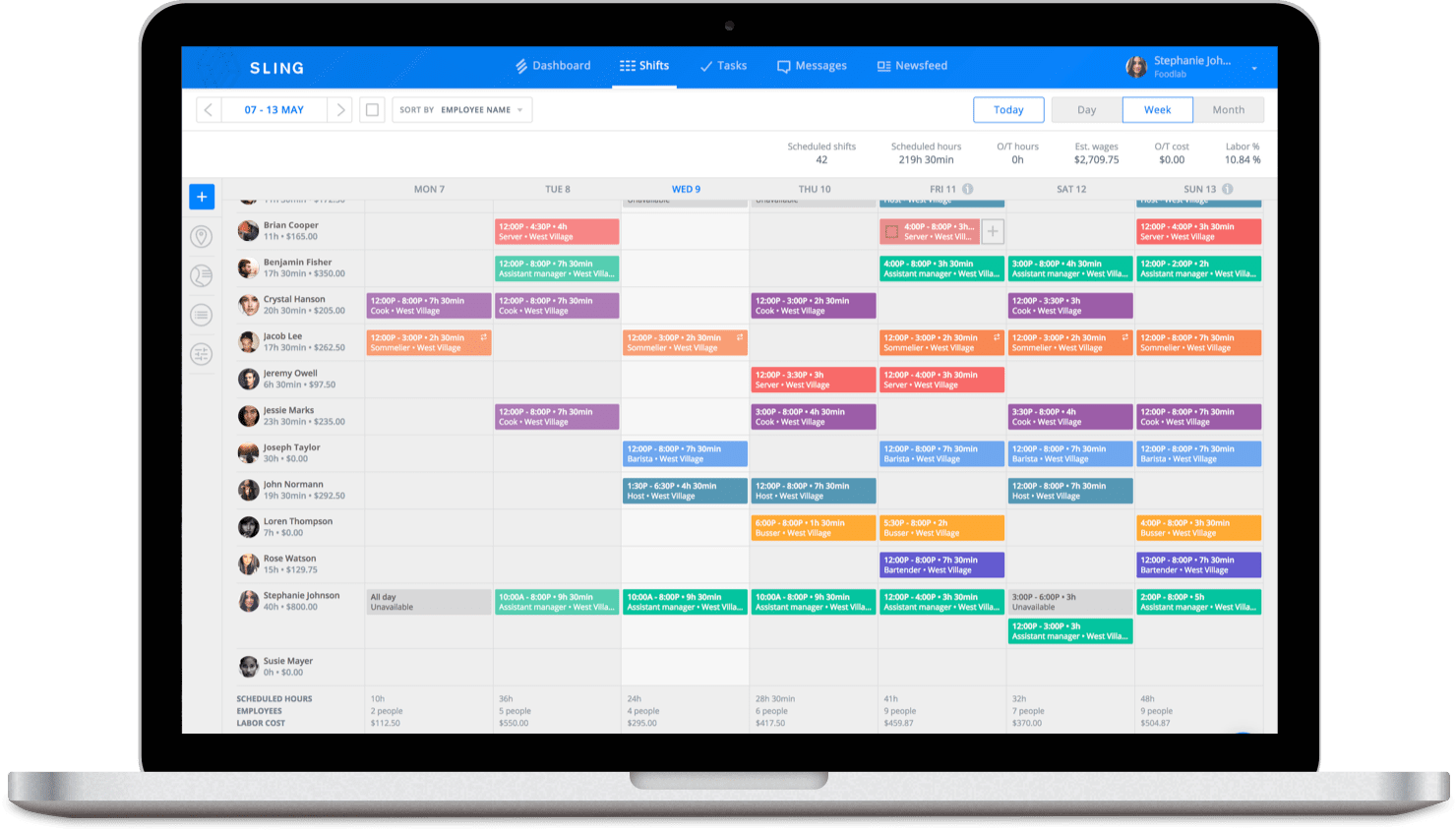How To Write Your Ideal Restaurant Mission Statement + 15 Inspiring Examples
Whether you run a one-person food cart, a small eatery with fewer than five empl...

In today’s fast-paced, ever-changing business environment, implementing group cohesion strategies can mean the difference between success and failure. That’s because teamwork, cooperation, and unity are at the heart of all great teams.
Whether you’re building a team for the first time or trying to improve unity in an existing team, use these 10 group cohesion strategies to help you get the job done.

Owners and managers alike understand the importance of creating a mission statement for their business.
Whether it’s posted on the wall for all to see or saved on a hard drive somewhere, your mission statement serves as a roadmap or action plan that guides your business toward success.
As beneficial as a mission statement is for your business as a whole, it can be just as beneficial when applied on a smaller scale to your team (or even to an individual).
Sit down with your employees and establish a team-specific mission that will guide them in both their everyday work and all their long-term goals.
When everyone is working toward the same mission, group cohesion will soar.
Your business will develop its own preferred methods of finding employees, but the most important aspect of it all is recruiting the best fit for the group cohesion of your team.
“Best fit” means something different to everyone, so it’s vital for your business to create a staffing model to help identify what type of employee will most benefit the team.
Once you’ve identified what your business needs, you can recruit accordingly. This may mean rehiring a past employee, contacting past applicants, promoting from within, or finding someone completely new.
However you choose to recruit potential team members, be sure to keep the idea of group cohesion in mind at all times.
Diversity in the workplace is essential for success. It fosters creative innovation and gives your team more skill, more talent, and more experience. That translates to higher productivity, increased motivation, and improved employee performance.
If you want those things for your team, hire with diversity in mind. Whether you’re looking for a barista, a food runner, or a customer service rep, hire people of all ages, backgrounds, and experience levels.
The mix of cultures, viewpoints, and personalities will create better group cohesion.
When everyone is working toward the same objective, jobs get done much quicker and with better results.
That’s why it’s vital to establish both individual and team goals right from the start. Without them, conflict and competition will develop and ruin the group cohesion you’ve worked so hard to create.
As a manager, you can set many of the goals your team will work on. But don’t neglect their input as well. Get them involved in the goal-setting process. When you do, you ensure that they understand the team’s objective and are fully engaged in making it happen.

Group cohesion doesn’t happen overnight. It takes time, effort, and patience. Don’t let that deter you, though. Practicing teamwork is the perfect way to build cohesion in your team.
Whether you choose team-building games, leadership activities, ice-breaker games, or engagement activities, practicing teamwork in a fun and productive way will bring your team together and promote cohesion among its members.
An easy way to foster group cohesion is to emphasize inclusion for all employees. At its most basic, inclusion is about making sure each and every team member feels valued.
You can do this by ensuring that all employees:
To get started promoting inclusion — and making your group cohesion stronger — show your employees that their thoughts, ideas, and perspectives matter.
In addition, make sure that you and your team consider every point of view before settling on a decision that affects your business.
The power of diversity — and these group cohesion strategies — is only successful when you allow everyone on your team to play an active role.
Your team needs a mix of many skills, and each individual brings different strengths to the table.
One person may have more technical expertise, another may have organizational and administrative skills, while another may have high financial aptitude. It’s the mix of all these skills that makes your team strong.
One of the best ways to get everyone involved is to make sure that they feel as though you value their contribution. When they believe the benefits they bring to the table are key to the success of the team, they will be more likely to play an active role.

Building trust — between you and your employees and between every member of the team — is one of the most important group cohesion strategies on this list. Without it, everything else you do will be less successful (or not successful at all).
To build trust, create a safe space where team members can share ideas and opinions without the fear of ridicule or rejection.
When your employees know that communication can occur without judgment, they’ll be more likely to open up, put their trust in each other (and you), and work together for a common goal.
Your business should never stop striving for better cohesion. But how do you know if things are going well or not?
Take the time to step back once in a while and evaluate the group cohesion among your team.
All owners and managers are familiar with the importance of conducting regular employee evaluations. The same concept can be applied to examining group cohesion in your business.
Such an examination can be as simple as asking how an employee feels about the team during a performance review or on a self-evaluation, or as involved as observing your team in action for a few days.
However you choose to evaluate group cohesion, schedule time at least once a year (though more often is better) to take a step back and see if your strategies are actually working.
As a manager, you are the guiding force for your team. Does that mean you need to do everything for them? Absolutely not. It’s your job to communicate the necessary objectives, then get out of the way and let them do their jobs.
Oftentimes, that means delegating authority. By giving your team members the power to make decisions on their own, you help them stretch, grow, and improve. That, in turn, goes a long way toward building group cohesion.
When you do delegate authority, just make sure that everyone is clear about when they still need to get your authorization.
You can increase group cohesion by resolving conflicts and arguments between team members right away. Some constructive conflict (friendly disagreement) can build the team up, but if that conflict escalates to real discord, it can tear the team down until no cohesion is left.
When real conflict does occur, give your team members the chance to resolve it on their own. If they can’t reach an accord, take the opportunity to step in, mediate, and facilitate a solution.

Whether it’s the end of a project or an individual job well done, it’s key to group cohesion that you celebrate those successes. And don’t be the only one to offer kudos and appreciation; encourage your team to celebrate without you as well.
By all means, arrange for a team lunch after the successful rollout of a new product or service, but then let them go out for drinks after work on their own. Doing so builds camaraderie, acts as an incentive for the next round of work, and reinforces the group cohesion you’ve already built.
You can’t build trust, resolve conflict, or do anything on this list without good communication. It really is the bedrock on which all successful teams are built.
To improve group cohesion (and facilitate all these group cohesion strategies), encourage open and honest communication with you and with each other.
Keep in mind that that communication should not be a one-way street. When your team members communicate with you, be sure to return the favor.
All work and no play actually makes your team less cohesive. That’s why it’s key to the success of your team that you set aside time for fun once in a while.
When you allow your team to socialize, celebrate, and just unwind (with or without you), you make it easier for them to forge meaningful relationships. It’s those relationships that will keep group cohesion high even when the work gets difficult.

Providing feedback is a big part of the open and honest communication process.
You should feel comfortable giving your team members feedback, and they should feel comfortable receiving it. Similarly, your team members shouldn’t be afraid to give feedback when the need arises.
To help your team members see the value of commenting on performance (and to improve group cohesion), make feedback mandatory.
No matter how hard you try to foster group cohesion in your business, some personalities just won’t mesh.
That doesn’t mean you have to start letting people go. It could be as simple as switching up who works with whom day in and day out.
You can gain insight into this aspect of your team by conducting a workplace personality test during the hiring process or during one of your mid-year performance reviews.
With this information in hand, you can help your team members get to know themselves and their teammates better and come up with ways that everyone can work better together.
We talked earlier about how you can improve cohesion by practicing teamwork with games and activities. Discussing group cohesion during on-the-job training is another way to promote unity among your team.
You can even incorporate this topic into new-hire training and virtual training for remote workers with excellent effect.

While owners and managers often want to focus on the big picture when it comes to group cohesion, sometimes it’s more beneficial to zoom in on the individual and start from there.
Nurturing team morale one team member at a time is a great way to pave the way for bringing everyone together as a cohesive unit.
Once individual morale is high, you can turn your attention to making sure each member of the team works well with the other members of the team.
Employee engagement is the ability of your team members to be present in the moment, focused on the task at hand, and energized about achieving good results.
This feeling motivates your employees to go above and beyond what you expect of them because they feel that they have a higher purpose — be it for the success of your business, the cohesion of your team, or the betterment of your clients and customers.
For suggestions on how to foster employee engagement within your business, check out his article from the Sling blog: 30 Employee Engagement Ideas For a More Productive Team.
Setting goals at the team and individual levels is an important part of fostering strong group cohesion.
You can take that concept even further by making group cohesion a part of your functional, business, and corporate strategies.
This helps keep the concept and practice of team unity in full view at all times and reinforces just how important it is to you, your employees, your teams, and your business.
For more insight into establishing guiding strategies for your business, take a few minutes to read these articles from the Sling blog:
When you focus on creating a productive, cohesive group of employees, you sync your team for success. But cohesion doesn’t happen overnight. It takes creativity, communication, commitment, and follow-through.
Start by choosing one or two of the group cohesion strategies on this list. Practice them for a while until they become a part of your managerial routine. Then choose one or two more. Soon, your team will be a high-functioning, cohesive unit on their way to success.

Many of the group cohesion strategies on this list aren’t part of the typical standard operating procedure. They’re practices an owner or manager can build on top of the foundation on which the business sits.
In some cases, though, rather than implementing new policies and procedures to grow group cohesion, a business may benefit from going back to basics and perfecting its core practices first.
One such core practice is scheduling.
Scheduling may seem like a simple, straightforward activity, but, in reality, it’s one of the more complicated processes your business will face.
So many integral aspects of your business depend on scheduling that, if there’s a bump somewhere along the way, you and your team are going to feel it.
The “bump” may manifest itself in employee satisfaction, payroll, time tracking, communication, or any number of other places within your business.
If that seems like a lot to manage, that’s because it is.
But when you optimize your business’s scheduling practices, you smooth out the bumps so that everything runs as it should.
From that stable and efficient foundation, you can then begin to build a strong sense of group cohesion for your team.
How, though, can you improve a process like scheduling that already exists within your business? With the help of powerful software like Sling.
The Sling suite of tools makes it easy to:
The built-in artificial intelligence even provides suggestions for better scheduling and notifies you when there’s a conflict.
Sling truly is the all-in-one solution to help you perfect your scheduling activities so you can focus your time and energy on implementing group cohesion strategies in your business.
For more free resources to help you manage your business better, organize and schedule your team, and track and calculate labor costs, visit GetSling.com today.
See Here For Last Updated Dates: Link
This content is for informational purposes and is not intended as legal, tax, HR, or any other professional advice. Please contact an attorney or other professional for specific advice.
Schedule faster, communicate better, get things done.